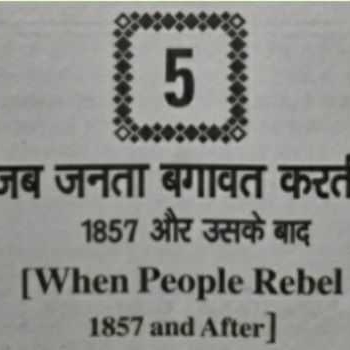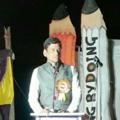Question 1 :
State True or False: Among all the chords of a circle passing through a given point inside the circle that one is smallest which is perpendicular to the diameter passing through the point.
Question 2 :
Sector is the region between the chord and its corresponding arc. TRUE or FALSE?
Question 3 :
Two chords AB and AC of a circle subtends angles equal to $90^{\circ}$ and $150^{\circ}$, respectively at the centre. Find $\angle BAC$, if AB and AC lie on the opposite sides of the centre.
Question 4 :
<img style='object-fit:contain' src='https://teachmint.storage.googleapis.com/question_assets/cbse_ncert/61b1d119f59b460d7261f3cd.PNG' />
In the above figure, AOB is a diameter of the circle and C, D, E are any three points on the semi-circle. Find the value of $\angle ACD+\angle BED$.
Question 5 :
State whether the given statement is true or false:- Through three collinear points a circle can be drawn.
Question 6 :
If the sum of a pair of opposite angles of a quadrilateral is 180º, the quadrilateral is cyclic. TRUE or FALSE?
Question 7 :
A chord of a circle, which is twice as long as its radius, is a diameter of the circle. TRUE or FALSE?
Question 8 :
If two intersecting chords of a circle make equal angles with the diameter passing through their point of intersection, then the chords are equal. True or False?
Question 9 :
<img style='object-fit:contain' src='https://teachmint.storage.googleapis.com/question_assets/cbse_ncert/61b1d11cf59b460d7261f3d1.PNG' />
State Yes or No: In the above figure, AB and CD are two chords of a circle intersecting each other at point E. Then $\angle AEC=\frac{1}{2\ }$ (Angle subtended by arc CXA at centre + angle subtended by arc DYB at the centre).
Question 10 :
State whether the given statement is true or false:- If A, B, C, D are four points such that $\angle BAC=30^{\circ}$ and $\angle BDC=60^{\circ}$, then D is the centre of the circle through A, B and C.
Question 11 :
Two circles of radii 5 cm and 3 cm intersect at two points and the distance between their centres is 4 cm. Find the length of the common chord.
Question 12 :
State whether the given statement is true or false:- There is one and only one circle passing through three given non-collinear points.
Question 13 :
Draw different pairs of circles. What is the maximum number of common points?
Question 14 :
AB and AC are two equal chords of a circle. State whether the bisector of the angle BAC passes through the centre of the circle or not.
Question 15 :
State whether the given statement is true or false:- Two congruent circles with centres O and O′ intersect at two points A and B, then $\angle AOB=\angle AO'B$.
Question 16 :
<img style='object-fit:contain' src='https://teachmint.storage.googleapis.com/question_assets/cbse_ncert/61b1d117f59b460d7261f3c9.PNG' />
In the above figure, state whether the given statement is true or false:- if AOB is a diameter and $\angle ADC=120^{\circ}$, then $\angle CAB=30^{\circ}$.
Question 17 :
State whether the given statement is true or false:- A circle of radius 3 cm can be drawn through two points A, B such that AB = 6 cm.
Question 19 :
If chords of congruent circles subtend equal angles at their centres, then the chords are not necessarily equal. TRUE or FALSE?
Question 20 :
<img style='object-fit:contain' src='https://teachmint.storage.googleapis.com/question_assets/cbse_ncert/61b1d116f59b460d7261f3c8.PNG' />
In the above figure, $\angle AOB=90^{\circ}$ and $ \angle ABC=30^{\circ}$, then $\angle CAO$ is equal to
Question 21 :
<img style='object-fit:contain' src='https://teachmint.storage.googleapis.com/question_assets/cbse_ncert/61b1d21cf59b460d7261f541.PNG' />
In the above fig, ABCD is a quadrilateral in which P, Q, R and S are mid-points of the sides AB, BC, CD and DA. AC is a diagonal. SR and AC are related as ______________.
Question 22 :
State true or false : Diagonals of a rectangle bisect each other and are equal and vice-versa.
Question 23 :
The diagonals AC and BD of a parallelogram ABCD intersect each other at the point O. If $\angle DAC = 32^{\circ}$ and $\angle AOB = 70^{\circ}$, then $\angle DBC$ is equal to
Question 24 :
Can all the four angles of a quadrilateral be obtuse angles?
Question 25 :
State true or false : The quadrilateral formed by joining the mid-points of the sides of a quadrilateral, taken in order, is a parallelogram.
Question 27 :
<img style='object-fit:contain' src='https://teachmint.storage.googleapis.com/question_assets/cbse_ncert/61b1d206f59b460d7261f522.PNG' />
In the above fig, if the diagonals of a quadrilateral bisect each other, then it is a ____________.
Question 28 :
Diagonals AC and BD of a quadrilateral ABCD intersect each other at O such that OA : OC = 3 : 2. Is ABCD a parallelogram?
Question 29 :
State true or false : A diagonal of a parallelogram divides it into two congruent triangles.
Question 31 :
P is the mid-point of the side CD of a parallelogram ABCD. A line through C parallel to PA intersects AB at Q and DA produced at R. Which statement is true for the following condition?
Question 32 :
<img style='object-fit:contain' src='https://teachmint.storage.googleapis.com/question_assets/cbse_ncert/61b1d20cf59b460d7261f52b.PNG' />
In ∆ ABC shown in the above fig, D, E and F are respectively the mid-points of sides AB, BC and CA. ∆ ABC is divided into four triangles by joining D, E and F. How many of these triangles are congruent ?
Question 34 :
ABCD is a parallelogram. If its diagonals are equal, then find the value of $\angle ABC$.
Question 35 :
<img style='object-fit:contain' src='https://teachmint.storage.googleapis.com/question_assets/cbse_ncert/61b1d21bf59b460d7261f540.PNG' />
ABCD is a trapezium given in the above fig in which AB || CD and AD = BC. Diagonals AC and BD are unequal. TRUE or FALSE ?
Question 36 :
D and E are the mid-points of the sides AB and AC respectively of $\triangle ABC$. DE is produced to F. To prove that CF is equal and parallel to DA, we need an additional information which is
Question 37 :
If the diagonals of a parallelogram are equal, then it is a ____________.
Question 38 :
<img style='object-fit:contain' src='https://teachmint.storage.googleapis.com/question_assets/cbse_ncert/61b1d215f59b460d7261f538.PNG' />
In ∆ ABC and ∆ DEF in the above fig, AB = DE, AB || DE, BC = EF and BC || EF. Vertices A, B and C are joined to vertices D, E and F respectively. Quadrilateral BEFC is a ______________
Question 39 :
Diagonals of a parallelogram are perpendicular to each other. Is this statement true?
Question 40 :
<img style='object-fit:contain' src='https://teachmint.storage.googleapis.com/question_assets/cbse_ncert/61b1d20bf59b460d7261f529.PNG' />
In the above fig, ABCD is a parallelogram in which P and Q are mid-points of opposite sides AB and CD. If AQ intersects DP at S and BQ intersects CP at R, then PSQR is a _______________.
























